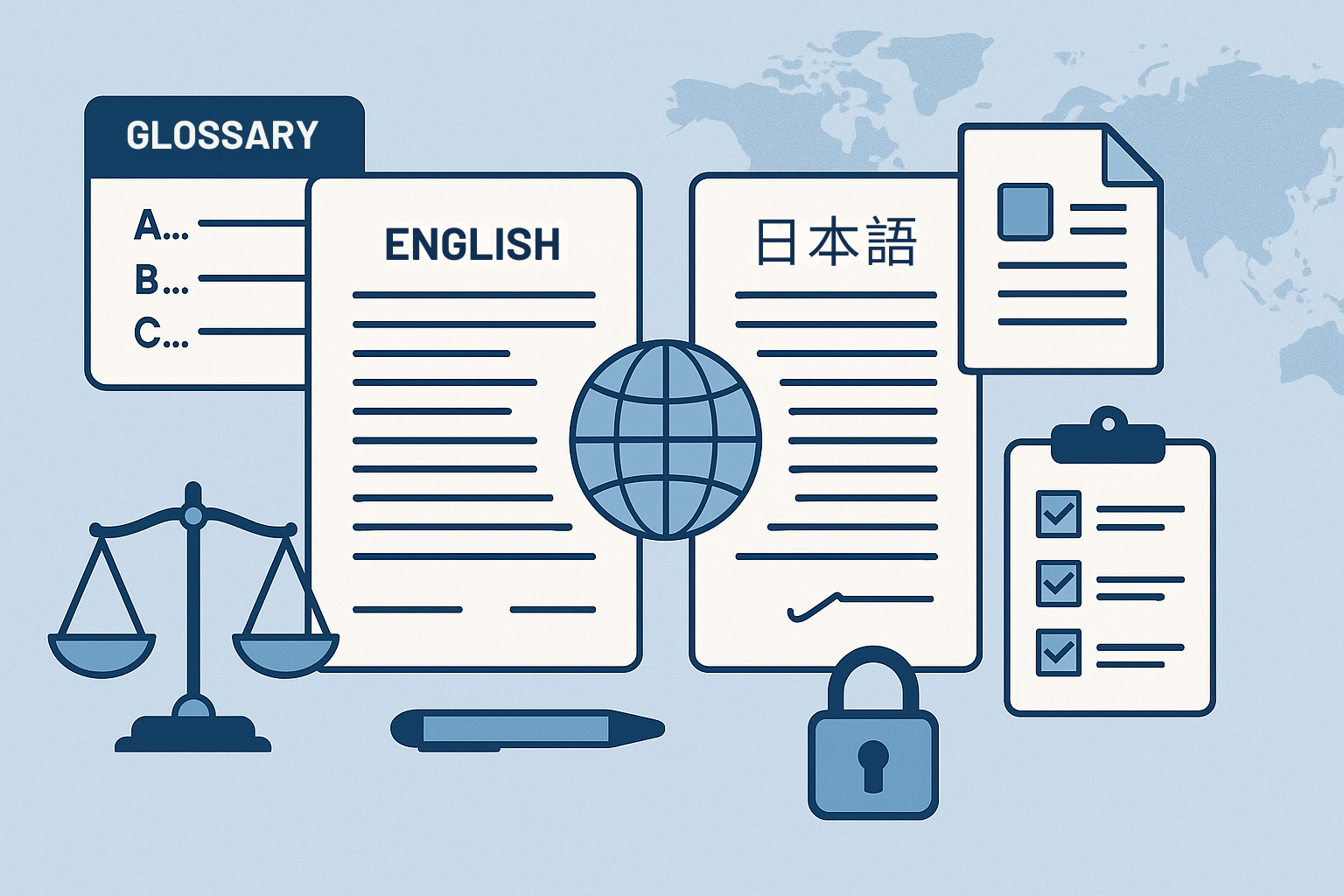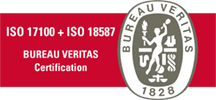Legal translation: how to brief your translator with glossaries and references
Legal translation demands precision. A clear brief with the right glossaries and references prevents costly rework and delays.

Table of Contents
Why legal translation succeeds or fails: the brief
Strong outcomes in legal matters are rarely an accident. They reflect a disciplined briefing process that aligns scope, terminology and expectations from day one. When stakes include enforceability, liability or regulatory deadlines, ambiguity is expensive.
A concise brief gives your linguist the same orientation your legal team has: the document’s role in the matter, who will read it, and what cannot be changed. If you are engaging full legal translation services, pair the brief with a realistic deadline and a named contact for queries — this reduces the back-and-forth and preserves momentum.
Finally, decide how comments and redlines will be handled. Will counsel review a first pass, or do you require a publication-ready final? Clarifying this up front protects the schedule and budget while maintaining quality.
What to include in a legal translation brief
A good brief is short, structured and repeatable. Include: purpose (e.g., filing, disclosure, due diligence), audience (judge, regulator, counterparties), jurisdiction(s), and desired register (formal, plain language, bilingual layout if needed). Note any strict formatting such as clause numbering, footnotes or exhibits.
Add a terminology section that points to your approved glossary and any terms to keep in the source language. If your organisation uses internal policy names or product labels, mark them as “do not translate”.
List authoritative references: past translations you liked, bilingual templates, style preferences and citations. If certification is required, indicate whether you need certified translations for official use and to which standards (for example, the ISO 17100 standard).
Close with logistics: delivery format (DOCX, PDF, bilingual table), QA expectations, and one decision-maker for terminology. If timing is tight, request a partial delivery plan for critical sections first.
Build a lean, living glossary
Your glossary is not a dictionary; it is a decision log. Start with 30–80 high-impact terms that appear across matters — company names, product families, clause headings and legal concepts. Keep entries simple: term, approved translation, context note, and example sentence.
Create it before translation begins, not after. Ask your provider to propose candidates based on frequency analysis and their existing customised glossaries process. When ambiguity exists, add a “preferred/avoid” note rather than leaving room for interpretation.
Host the glossary centrally so your team and the linguists can update it — versioned, with change history. This supports textual coherence across contracts and ensures later projects inherit the same decisions.
Review cycles should be lightweight: appoint a legal reviewer to approve batch updates. Over time, the glossary becomes a risk-reduction asset that speeds estimates, improves quality control, and reduces disputes about wording.
Pack the right reference files
Translators work faster and more accurately with good exemplars. Provide a small, curated set of references: a recent signed agreement in both languages, litigation filings, and any regulator-mandated templates. Avoid dumping entire data rooms; signal which files are authoritative.
Include style and quality benchmarks. If you require compliance with ISO 17100 certification processes or post-editing under ISO 18587 certification, say so and share any internal SOPs. This aligns terminology approval, reviewer roles and delivery checks.
When your matter involves technical domains — for example, patents or engineering contracts — include links to relevant technical translation resources or glossaries to bridge legal and technical vocabulary.
For public-sector or EU work, add links to authoritative external terminology bases such as the EU’s IATE terminology and court style rules. These references help resolve edge cases and keep phrasing consistent with the target jurisdiction.
Context: case, jurisdiction, audience
Context eliminates guesswork. State where the document will be used and which legal system governs it. “Portugal, administrative law” leads to different choices than “Brazil, consumer protection” or “Spain, employment law”. If multiple jurisdictions appear, rank them by authority for terminology decisions.
Identify the audience’s expectations. Judges may prefer conservative, source-faithful renderings; compliance teams often want plain language. If the audience will compare bilingual columns, ask for aligned paragraph breaks to aid review.
Specify critical constraints: do you need a sworn or notarised deliverable, or simply a professional legal translation with a certificate of accuracy? Do you require a fixed character count for forms? These details inform layout and help avoid rework.
Workflow, QA and confidentiality
Agree on a workflow that matches risk. Complex matters benefit from translation → independent revision → final rigorous review by a senior linguist or lawyer-linguist. For time-sensitive tasks, consider segmenting: translate priority clauses first, then the remainder.
Define QA gates. Your provider should document checks for numbers, citations, cross-references and defined terms. Ask how they ensure accurate translations when the source is a scan or contains handwritten edits. If certification is needed for courts or authorities, confirm the exact steps and whether a stamped hard copy is required. For post-editing workflows, align expectations with ISO 18587.
Confidentiality is non-negotiable. Require NDAs for all personnel involved and secure hand-off methods. When appropriate, request restricted access project spaces and deletion of working files on completion. For long-running engagements, continuous improvement and continuous evaluation help spot recurring issues early.
Common pitfalls and how to avoid them
Overlong briefs. Ten-page instructions are rarely read. Keep the brief to two pages plus annexes; put living content (glossary, style) in shared links.
Vague terminology. Words like “preferably” or “maybe” create rework. Decide, document and move on. If stakeholders disagree, record the compromise in the glossary and mark it for later review.
Late references. Sending key documents after translation starts triggers inconsistencies. Share references up front, then freeze the set unless something critical changes.
No clear owner. Assign one person to resolve questions quickly. When everyone owns terminology, no one does.
Skipping final checks. Even excellent linguists miss things. Build in a second look and, when appropriate, a critical review to challenge assumptions and remove noise.
FAQ
Q1. What makes a good legal translation brief?
A strong brief is focused and actionable. It identifies the document’s purpose, audience and governing jurisdiction; sets the desired register; and lists the non-negotiables such as clause numbering, footnotes and exhibits. It also points to a concise glossary that covers high-frequency terms and branded language, and explains any “do not translate” items like product names. By giving this backbone to your translator, you reduce ambiguity and accelerate decision-making during the project.
Equally important are references and logistics. Share a few authoritative sample documents, clarify whether you need certification and which standard applies, and specify delivery formats. Finally, name a single contact with availability to answer queries. This combination of clarity, examples and decision-making speed is what turns a brief into results.
Q2. How detailed should our glossary be for legal work?
Start small and purposeful. A glossary with 30–80 terms is easier to maintain and actually used by linguists. Each entry should include the source term, the approved translation, a short context note and, ideally, an example sentence. Avoid encyclopedic definitions; the aim is repeatable choices, not theory.
Treat the glossary as a living artefact. Ask your translation partner to propose candidates based on frequency and risk, and to record changes with version history. Schedule lightweight approvals by a lawyer-linguist so terms stay aligned with your practice. Over time, the glossary cuts review cycles, improves consistency and forms part of your quality management system.
Q3. Which references help translators most in legal matters?
High-value references are recent, relevant and authoritative. Provide a bilingual agreement you consider exemplary, regulator-issued templates, and any court style guides that apply. If your matter spans sectors — say, finance plus technology — include cross-domain materials so terminology decisions are coherent across sections.
Avoid clutter. Giant archives slow the team down and hide the signal. Curate the “golden set” and label it as authoritative. If your organisation uses specific drafting conventions, add a short style sheet. This helps linguists and reviewers converge on the same standards from the first page.
Q4. How do we balance speed and quality when deadlines are tight?
Prioritise ruthlessly and structure the workflow. Split the document by risk: translate and review the critical clauses first, then the lower-risk sections. Ask for rolling deliveries so counsel can start checking earlier. Meanwhile, protect quality by keeping the glossary tight, appointing a single decision-maker for terminology, and requiring an independent revision step.
Technology can help but must be controlled. Reuse past approved translations for recurring clauses, and consider post-editing for routine sections while keeping human-only handling for sensitive content. For court or regulator submissions, always include a final senior review to catch cross-references, definitions and numbering issues before filing.
Links
- Internal:
- External:

